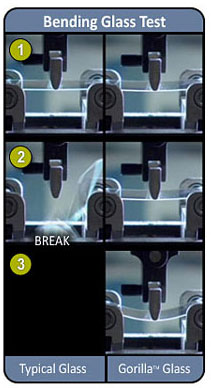« Gotcha, fool! Your friends at AT&T | Main | Getac to offer multi-touch on its V100 rugged Tablet PC »
October 7, 2009
Gorilla Glass -- lighter and tougher display protection
On October 6, 2009, Motion Computing announced that their C5 and F5 were the first Tablet PCs to use Corning's Gorilla Glass. What is Gorilla Glass? In its press release, Motion states that it is "thin-sheet glass that was designed to protect against real-world events that cause display damage."
To learn more I scheduled a call with Corning's Dr. Nagaraja Shashidhar. To prepare myself I checked Corning's very informative page on Gorilla Glass. They have some videos there that show the glass being bent and steel balls falling onto it. The glass neither shatters nor breaks. In fact, it's hard to believe it's glass at all. It looks more like a very thin sheet of some polycarbonate plastic or acrylic. But it is glass.
 The secret, according to Dr. Shashidhar, lies in a special chemical ion-exchange strengthening process that results in what Corning calls a "compression layer" on the surface of the glass. The primary purpose of that layer is to act as an armor that guards against the nicks and tiny cracks that then result in the glass breaking. And even if there are tiny nicks, the layer keeps them from propagating.
The secret, according to Dr. Shashidhar, lies in a special chemical ion-exchange strengthening process that results in what Corning calls a "compression layer" on the surface of the glass. The primary purpose of that layer is to act as an armor that guards against the nicks and tiny cracks that then result in the glass breaking. And even if there are tiny nicks, the layer keeps them from propagating.
What's amazing is just how thin the glass is. Corning makes it in thicknesses ranging from 0.5mm to 2mm, or 1/50th to 1/12th of an inch. The Gorilla Glass used in the Motion tablets is just 1.2mm thick, yet it provides the protection of a much thicker layer of protective glass at a fraction of the weight. And a thinner layer of protective glass doesn't only mean less weight, it also makes for a more natural feel when using the tablet. With thick glass it sometimes looks like the tip of the pen hovers far above the actual screen. That's not the case with the Gorilla Glass-equipped Motion tablets.
I had actually had some face time with a Motion F5 tablet with the new glass before Motion announced it. I took the opportunity to not only examine the new display, but also benchmark performance and battery life with the new and more powerful processor Motion now uses for the C5 and F5. I also did side-by-side comparisons between an original Motion F5 and the latest model (see full report).
I must admit that it's a bit hard to figure out all the F5's display technologies. You start with a Hydis display that now has AFFS+ technology for not only a totally perfect viewing angle in all directions, but also superior brightness. You then add the Gorilla Glass cover that significantly increases the durability of the display. On top of it all is Motion's View Anywhere, which is an anti-reflective sputtered coating on the front side of the glass that is optically bonded to the display.
How does it work? Extremely well. Between the super-wide viewing angle (which makes for an unbelievably "stable" display) and the excellent sunlight viewability, this is a machine that you can really use outdoors. The Gorilla Glass adds peace of mind (no, I didn't try to break it). And the Gorilla Glass also has another benefit that may turn out to be quite a selling point for Motion: it's nearly immune to smudges. There's nothing worse than a display that's full of grime and fingerprints, and that just doesn't seem to be an issue with Gorilla Glass.
So there. It's a funny name, Gorilla Glass, but it's definitely a good thing. And I am not surprised that Motion is the first to have it on a tablet. They always seem to adopt new stuff first.
Posted by conradb212 at October 7, 2009 2:47 AM

















